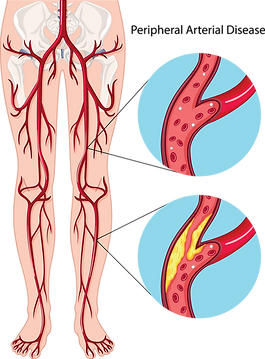Peripheral Artery Disease
Peripheral artery disease PAD (also called peripheral arterial disease) is a common circulatory problem in which narrowed arteries reduce blood flow to your limbs.
When you develop peripheral artery disease (PAD), your extremities — usually your legs — don't receive enough blood flow to keep up with demand. This causes symptoms, most notably leg pain when walking (intermittent claudication).
Peripheral artery disease is also likely to be a sign of a more widespread accumulation of fatty deposits in your arteries (atherosclerosis). This condition may be reducing blood flow to your heart and brain, as well as your legs.
Often, you can successfully treat peripheral artery disease by quitting tobacco, exercising and eating a healthy diet.

Symptoms
While many people with peripheral artery disease have mild or no symptoms, some people have leg pain when walking (intermittent claudication).
Intermittent claudication symptoms include muscle pain or cramping in your legs or arms that's triggered by activity, such as walking, but disappears after a few minutes of rest. The location of the pain depends on the location of the clogged or narrowed artery. Calf pain is the most common location.
The severity of intermittent claudication varies widely, from mild discomfort to debilitating pain. Severe intermittent claudication can make it hard for you to walk or do other types of physical activity.
Peripheral artery disease symptoms include:
Painful cramping in your hip, thigh or calf muscles after activity, such as walking or climbing stairs (intermittent claudication)
Leg numbness or weakness
Coldness in your lower leg or foot, especially when compared with the other side
Sores on your toes, feet or legs that won't heal
A change in the color of your legs
Hair loss or slower hair growth on your feet and legs
Slower growth of your toenails
Shiny skin on your legs
No pulse or a weak pulse in your legs or feet
Erectile dysfunction in men
If peripheral artery disease progresses, pain may even occur when you're at rest or when you're lying down (ischemic rest pain). It may be intense enough to disrupt sleep. Hanging your legs over the edge of your bed or walking around your room may temporarily relieve the pain.
When To See A Doctor
If you have leg pain, numbness or other symptoms, don't dismiss them as a normal part of aging. Call your doctor and make an appointment.
Even if you don't have symptoms of peripheral artery disease, you may need to be screened if you are:
Over age 70
Over age 50 and have a history of diabetes or smoking
Under age 50, but have diabetes and other peripheral artery disease risk factors, such as obesity or high blood pressure
Causes
Peripheral artery disease is often caused by atherosclerosis. In atherosclerosis, fatty deposits (plaques) build up in your artery walls and reduce blood flow.
Although the heart is usually the focus of discussion of atherosclerosis, this disease can and usually does affect arteries throughout your body. When it occurs in the arteries supplying blood to your limbs, it causes peripheral artery disease.
Less commonly, the cause of peripheral artery disease may be blood vessel inflammation, injury to your limbs, unusual anatomy of your ligaments or muscles, or radiation exposure.
Risk Factors
Factors that increase your risk of developing peripheral artery disease include:
Smoking
Diabetes
Obesity (a body mass index over 30)
High blood pressure (140/90 millimeters of mercury or higher)
High cholesterol (total blood cholesterol over 240 milligrams per deciliter, or 6.2 millimoles per liter)
Increasing age, especially after reaching 50 years of age
A family history of peripheral artery disease, heart disease or stroke
High levels of homocysteine, a protein component that helps build and maintain tissue
People who smoke or have diabetes have the greatest risk of developing peripheral artery disease due to reduced blood flow.
Complications
If your peripheral artery disease is caused by a buildup of plaques in your blood vessels (atherosclerosis), you're also at risk of developing:
Critical limb ischemia, This condition begins as open sores that don't heal, an injury, or an infection of your feet or legs. Critical limb ischemia occurs when such injuries or infections progress and can cause tissue death (gangrene), sometimes requiring amputation of the affected limb.
Stroke and heart attack, The atherosclerosis that causes the signs and symptoms of peripheral artery disease isn't limited to your legs. Fat deposits also build up in arteries supplying your heart and brain.

